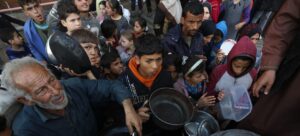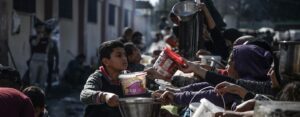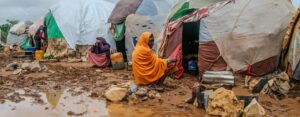July: Is a second half comeback possible?
2023 marked the midway point for the Sustainable Development Goals (SDGs), a blueprint for a better future adopted by all UN Member States in 2015. The half-time score showed that the world is falling behind on all of the 17 Goals and will struggle to achieve any of them by 2030.
The High-Level Political Forum (HLPF) – the big mid-year event at UN Headquarters to evaluate progress on the SDGs, held from 8 to 17 July – will be an opportunity to evaluate how much political will there is to turn them into a reality. Expect a focus on hunger and poverty, climate change, and sustainable development.
In other news: Look to the stars
If you caught the Brad Pitt movie Ad Astra in 2019, you might remember a seemingly outlandish shootout on the surface of the Moon. Yet, as the prospect of a lunar base being established in the next few years becomes more likely, there is a growing realization that, to avoid a potential free-for-all, there need to be international agreements on how to exploit the Moon’s resources.
The fresh attention prompted the General Assembly to designate 20 July – the anniversary of the Apollo 11 lunar landing –as International Moon Day, in a 2012 Resolution on “international cooperation in the peaceful uses of outer space”. Interest has grown since then, and this year around 42 events took place around the world, from workshops to panel discussions.
UN staff deliver life-saving water and food to some 500 families in a small village near Kherson, about 15 kilometres from the front line in Ukraine.
August: Honouring humanitarians
Humanitarian workers are recognised annually on World Humanitarian Day on 19 August for their contribution to the survival, well-being, and dignity of people affected by crises around the world.
The commemoration was established 21 years ago, after the UN headquarters in Baghdad, Iraq, was bombed and 22 aid workers, including the Special Representative of the Secretary-General for Iraq, Sergio Vieira de Mello, were killed.
The day which also focuses on the safety of humanitarians will recognize all those, including a record number in Gaza, who have lost their lives serving others.
In other news: Beat the drum
August will mark three years since the de facto Taliban authorities seized power in Afghanistan. The UN continues to provide humanitarian relief and crucially to advocate for human rights, especially those of women and girls.
When you have lemons, make lemonade. When you have an oil drum…make music! The idea of turning oil drums into steelpans began in Trinidad & Tobago in the early 20th Century, and the steelpan music that can now be heard around the world is a link to the West African percussive traditions kept alive by slaves taken to work on Caribbean plantations. The power and tradition of steelpan music is celebrated on 11 August, on World Steelpan Day.
The Summit of the Future to which all UN Member States are invited is due to take place from 22-23 September.
September: Look to the future, it’s only just begun
Look out for the Summit of the Future on 22 and 23 September, which aims to “forge a new international consensus on how we deliver a better [DD2] present and safeguard the future”. A “pact for the future” will be adopted, in the hope that it will lead to the international community effectively tackling current challenges, as well as those that have emerged in recent years or may yet be over the horizon.
The Summit will be the centrepiece of General Assembly High-Level week, traditionally the busiest time of the year at UN Headquarters.
The High-Level Debate, in which the leaders of Member States are invited to speak in the General Assembly building, will begin on Tuesday 24 September.
In other news: All in moderation
We will never be able to live in harmony with the planet, without taking a close look at the way we produce and consume. The One Planet Network, which includes UN agencies, governments, NGOs and academic institutions, aims to inspire a global movement for sustainable consumption and production, by sharing knowledge and encouraging action for change.
After holding its initial Forum in Stockholm in 2022, the second edition will take place on 12 September, and will identify fresh solutions, tools, and strategies for a sustainable future.
© Unsplash/K. P. D. Madhuka
Green forest lizards are found in forests in India and Sri Lanka.
October: Bringing biodiversity back from the brink
The natural world is facing a dangerous decline, and around one million species are under threat. Between 21 October and 1 November, the UN biodiversity conference will take place in Turkey, where delegates will discuss how to turn restore lands and seas in a way that protects the planet, and respects the rights of local communities.
The event will build on the historic achievement of a historic agreement reached by the international community, to protect nature, and set global targets to safeguard biodiversity. The challenge will be to turn these ambitious targets into action by 2030.
In other news: Feed the world
The world currently produces enough food to feed everyone, but last year more than 810 million people went hungry. To provide fresh impetus for a transformed global food system, the UN held the first World Food Forum in Rome in 2023, a four-day youth-led event, featuring Heads of State, food influencers, artists, and UN experts.
The second edition, which begins on 14 October, will build on the success of the inaugural Forum, and continue the growth of a global movement to restore and renew agri-food systems, and eliminate hunger.
A participant attends the UN Climate Change Conference COP28 at Expo City Dubai.
November: The climate bandwagon moves to Azerbaijan
After three decades of UN climate conferences, the nations of the world finally expressed an aspiration to transition away from fossil fuels, at the 2023 conference in Dubai. This was hailed by some as some by a breakthrough, and the beginning of the end for dirty power sources, but many people, including António Guterres, the UN Secretary-General, were frustrated at the slow pace at which the world is moving towards a carbon-free future.
“A fossil fuel phase out is inevitable. Let’s hope it doesn’t come too late,” said Mr. Guterres in response to the declaration. With the focus on the climate crisis only likely to intensify next year, all eyes will be on Baku, Azerbaijan, from 11 to 24 November, host of the 2024 conference (COP29), to see if the pace of change can be sped up.
In other news: Cities on the agenda
The inexorable movement of populations from rural areas to urban conurbations shows no sign of slowing down, increasing the pressure on municipal authorities to provide adequate services for their citizens.
Over the past two decades, the World Urban Forum, established by the UN, has become the key global event on sustainable urbanization. The 12th edition will be held from 4–8 November 2024 in Cairo, Egypt, just before the big COP29 meeting in Baku, and promises to be as inclusive as previous events, giving a wide range of people with a stake in making cities liveable, clean and thriving, the opportunity to have their say.
Girls play basketball on World Children’s Day in Sana’a, Yemen.
December: Nuclear safety in the spotlight
Nuclear energy has been touted as an important tool in the move to a zero-carbon energy system. However, fears about the safety of the energy sources persist: many still remember the environmental consequences of the Fukushima disaster in 2011, and the Chernobyl explosion in 1986.
From 2 – 6 December, the International Atomic Energy Agency (IAEA) will hold the fourth International Conference on Enhancing Nuclear Safety and Security in Vienna, Austria. The event will play a vital part in national and international efforts being made to ensure the effectiveness of nuclear and radiation safety, and the security of facilities and activities.
In other news: Hoops for peace?
There are dozens of general elections expected to take place across the world in 2024 including in South Sudan. The first post-independence elections which were due to be held in 2015, were delayed and will hopefully take place before the end of the year. The UN peacekeeping mission, UNMISS, is implementing proactive measures aimed at mitigating the risks of violence before, during and after voting.
Meanwhile, basketball which was first played in the US in 1891, is being recognized for its role in supporting the empowerment of women and girls, promoting peace and development, and respect for human rights.
The second World Basketball Day celebrations will take place on 21 December.






























